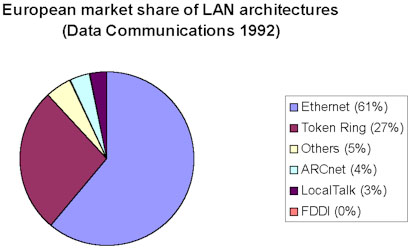-
Ethernet is a baseband networking technology
that has been defined by various standards.
A baseband technology devotes the entire bandwidth
of the media to one channel. Simplistically, bandwidth can be defined as
a measure of network capacity - the greater the available bandwidth, the
greater the network's resilience to loading. The inclusion of the word
"base" in 10BaseT, 10Base5 etc., simply refers to ethernet's baseband nature.
-
There are no levels of priority for transmission. All computers on an
ethernet network are considered equal in terms of their access to the media.
In contrast to token ring, there is no monitoring
station that controls the network.
-
Unless it is switched :
-
ethernet uses carrier sensed multiple access with collision detection
(CSMA/CD) as its method of medium access control.
-
data in the ether is accessable to all connected devices.
-
high loading on a LAN segment can lead to packet
collisions and a marked drop in network efficiency.
-
ethernet has a broadcast logical topology - data is sent to all nodes
on the network simultaneously:

-
As shown in the diagram, ethernet is the most dominant LAN technology:
 The
figures represented in the pie chart are relatively out of date, although
ethernet still remains the most common LAN architecture. ATM
has become important as a LAN technology in areas of the computing industry
where high data tranfer rates are required. Multimedia, computer graphics
and video conferencing all need fast networks, therefore ATM is a good
choice, but the emergent gigabit ethernet may
challenge ATM.
The
figures represented in the pie chart are relatively out of date, although
ethernet still remains the most common LAN architecture. ATM
has become important as a LAN technology in areas of the computing industry
where high data tranfer rates are required. Multimedia, computer graphics
and video conferencing all need fast networks, therefore ATM is a good
choice, but the emergent gigabit ethernet may
challenge ATM.
-
Ethernet conforms to the OSI model and covers
layer 1 - physical, and layer
2 - datalink (medium access control).
-
Interfaces have been developed to connect all types of computer, across
many types of media, to ethernet. PCs use a network
interface card to manage medium access control
and communicate with the layer 2 process.
![]()

 The
figures represented in the pie chart are relatively out of date, although
ethernet still remains the most common LAN architecture. ATM
has become important as a LAN technology in areas of the computing industry
where high data tranfer rates are required. Multimedia, computer graphics
and video conferencing all need fast networks, therefore ATM is a good
choice, but the emergent gigabit ethernet may
challenge ATM.
The
figures represented in the pie chart are relatively out of date, although
ethernet still remains the most common LAN architecture. ATM
has become important as a LAN technology in areas of the computing industry
where high data tranfer rates are required. Multimedia, computer graphics
and video conferencing all need fast networks, therefore ATM is a good
choice, but the emergent gigabit ethernet may
challenge ATM.